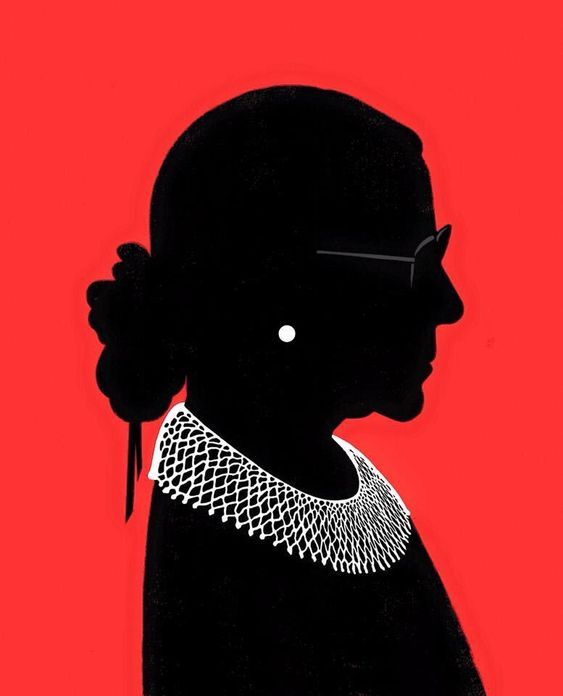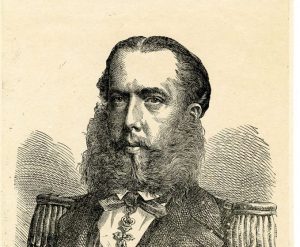Winner of the Spring 2019 StMU History Media Award for
Best Article in the Category of “Political History”
Being admitted into law school is difficult. Being admitted into Harvard Law is significantly harder. However, being admitted into Harvard Law as a female in the 1950s was near impossible. In the 1950s, a female’s hard work did not guarantee admission into any program. For the majority of Ruth Bader Ginsburg’s life, preferential treatment was always given to males, not only culturally and socially, but also in the eyes of the law. Nevertheless, she stood her ground in the face of adversity. The Notorious RBG has built her career on championing change in the law by fighting for equality for both sexes.

Ruth Bader Ginsburg, even in her early years, was no stranger to hardship. She grew up in a low-income Jewish family in Brooklyn, New York.1 It was during these years that Ginsburg’s mother taught her the most important of life’s lessons: independence. For Ginsburg, true independence is legal equality. She would be inspired by her mother’s life lesson, eventually, to fight for legal equality for all. Even with her mother’s passing while Bader Ginsburg was still in high school, her mother’s strong influence has followed her throughout her career.2
After the death of her mother the night before her high school graduation, Ruth enrolled for fall classes at Cornell University—where she eventually met her husband, Martin Ginsburg.3 After graduating from Cornell, Ruth and Martin moved to Kansas. While working for the Social Security Administration, she became pregnant. Despite her efforts to conceal her pregnancy, her superiors found out and demoted her—this would not be the only time Ginsburg would experience discrimination based on her gender.4 After her husband finished his time in the army, they both set their sights on law school. At the time of her admittance to Harvard Law in 1957, there was a grand total of eight women accepted into the program out of more than 500 students. During her first year of law school, Ginsburg and her women peers had dinner with the dean of the law school, Erwin Griswold. It was at this dinner that Griswold boldly asked the women in her class, “how they could justify taking the place of a qualified man?”5 That same year, her husband was diagnosed with testicular cancer. To support him, she completed her class responsibilities while helping him with his. While most of RBG’s law studies were completed at Harvard, she had to finish at Columbia. She fought to have her degree from Harvard, as there was a precedent for students’ to have their diploma from the school they had completed the majority of their studies. Nevertheless, Dean Griswold denied her request to have her LLB come from Harvard Law.6 When Bader Ginsburg graduated from Columbia Law in 1959, she was ranked number one in her class.7 Despite this fact, she was not hired by a single law firm in New York City and ended up as a professor at Rutgers’s Law School. As a law professor, she was able to take on any case she wished. She taught for years before taking on her first case, a tax law case in which a man was the victim of gender discrimination by the hand of the federal government.
RBG argued on behalf of Charles E. Moritz, alongside her husband, with the aid of the American Civil Liberties Union, Moritz v. Commission of Internal Revenue. It was during this lesser-known case, her first litigating case, that she first showcased her passion. In her early years, RBG’s mother had instilled in her a flexible perspective of the world, because people could take on many roles. To her, it made sense that bachelor Moritz should be afforded a tax break so he could be given the opportunity to take care of his mother. RBG believed this despite what society’s gender roles dictate that Moritz should do. During this first case, Bader Ginsburg was able to challenge institutionalized sexism, which at the time was legal. It is noteworthy that in her first case, her opposing counsel was one of her law professors from Harvard, Bozarth, and more importantly Dean Griswold of Harvard Law. Despite her skill and her impressive ability to write a perfect brief, she was still being underestimated by not only her legal foes and the court, but also by her own peers. For Bader Ginsburg, there was so much more than Mortiz’ $328.80 at stake.8 The future of legal gender discrimination was at stake. Up until this point, there were hundreds of laws differentiating citizens based on their gender, which was wrong and unethical to Bader Ginsburg. This is where her voice and ability to advocate for equality was able to ring loudly for the first time in the court of law–the unanimous decision by the 10th Circuit Appellate Court by Judge William Judson Holloway Jr. decided that differentiating a tax break on the basis of sex was in fact unconstitutional.9
In her role as lead counsel for the ACLU Women’s Rights Project, Ginsburg developed an effective strategy to achieve lasting results. Her strategy was to pick cases that were winnable and would set precedents to chip away at the legal barriers imposed on the basis of gender.10 In Kahn v. Shevin, for example, she represented a widower who believed he should be entitled to a Florida tax exemption that was usually only granted to widows. Later on, in Weinberger v. Wiesenfeld, Bader Ginsburg argued on behalf of a widower whose schoolteacher wife had been the family’s primary breadwinner. In all of these cases, while Bader Ginsburg, one of the most qualified attorneys of our time, was without a doubt underestimated at every single step.

Bader Ginsburg posing with her family members in the US Supreme Court | Courtesy of CNN
It was not until 1993, during the Clinton Administration, that she was nominated to the United States Supreme Court. She was appointed as the second woman ever and the first Jewish woman to serve on the United States Supreme Court.11 Her nomination and appointment to the United States Supreme Court finally gave Bader Ginsburg the platform that she needed to be able to interpret and read the letter of the law in a manner that would be fair. She could contribute to providing equality and protection under the law for all, which is what she had been fighting for her entire career as an attorney.
The Virginia Military Institute had a long-standing proud tradition and policy of only allowing the admission of men into the institution. The United States brought a case against the institution, stating that their tradition of gender discrimination violated the equal protection clause of the Fourteenth Amendment. This would be the first case that Bader Ginsburg would hear on the Supreme Court. United States v. Virginia, 518 U.S. 515 (1996), was a momentous case in which the Supreme Court of the United States struck down the long-standing male-only admission policy of the Virginia Military Institute (VMI) in a seven to one decision.12 Bader Ginsburg wrote, “a prime part of the history of our Constitution is the story of the extension of constitutional rights and protections to people once ignored or excluded.” Here, “there is no reason to believe that the admission of women capable of all the activities required of VMI cadets would destroy the Institute rather than enhance its capacity to serve the ‘more perfect Union.’”13 This case was the culmination of all of Bader Ginsburg’s trials and tribulations, which pushed her to work harder not for herself but to create a better world for the generations to follow her.

Being a woman in this world has never been easy, but women like Ruth Bader Ginsburg have become a beacon of hope for women everywhere because of her strong advocacy for equality no matter the gender, race, or religion. Ruth Bader Ginsburg, the second woman ever to be appointed to the United States Supreme Court, changed the momentum of the legal field for women. She has become an icon and inspiration to all women whether they are in the legal realm or not. Currently the oldest Supreme Court Justice, Ruth Bader Ginsburg has earned a reputation as a powerful voice for civil rights and gender equality. It is impossible not to be inspired by The Notorious RBG’s iconic determination and drive, which led to her historic appointment.
- Jane Sherron De Hart, Ruth Bader Ginsburg : A Life (New York : Alfred A. Knopf, 2018), 24-25. ↵
- Jane Sherron De Hart, Ruth Bader Ginsburg : A Life (New York : Alfred A. Knopf, 2018), 29-55. ↵
- Jane Sherron De Hart, Ruth Bader Ginsburg : A Life (New York : Alfred A. Knopf, 2018), 69-74. ↵
- Jane Sherron De Hart, Ruth Bader Ginsburg : A Life (New York : Alfred A. Knopf, 2018), 109-114. ↵
- Jane Sherron De Hart, Ruth Bader Ginsburg : A Life (New York : Alfred A. Knopf, 2018), 124. ↵
- Jane Sherron De Hart, Ruth Bader Ginsburg : A Life (New York : Alfred A. Knopf, 2018), 133. ↵
- Jane Sherron De Hart, Ruth Bader Ginsburg : A Life (New York : Alfred A. Knopf, 2018), 146. ↵
- “Moritz V. Commissioner Of Internal Revenue, 55 T.C. 113.” (1970), Casetext. https://casetext.com/case/moritz-v-commissioner-of-internal-revenue. ↵
- “Moritz V. Commissioner Of Internal Revenue, 55 T.C. 113,” (1970), Casetext. https://casetext.com/case/moritz-v-commissioner-of-internal-revenue. ↵
- Jane Sherron De Hart, Ruth Bader Ginsburg : A Life (New York : Alfred A. Knopf, 2018), 154-175. ↵
- Jane Sherron De Hart, Ruth Bader Ginsburg : A Life (New York : Alfred A. Knopf, 2018), 190-203. ↵
- “United States V. Virginia Case Summary,” 2017. University of Hawaii School Of Law Library. Https://library.law.hawaii.edu/2017/01/23/united-states-v-virginia-case-summary/. ↵
- “United States V. Virginia Case Summary,” 2017. University of Hawaii School Of Law Library. Https://library.law.hawaii.edu/2017/01/23/united-states-v-virginia-case-summary/. ↵



101 comments
Lesley Martinez
Supreme Court Justice Ruth Bader Ginsburg is one of my greatest inspirations. Her admission into Harvard as one of only eight women accepted into the program is surprising. Additionally, her dedication to getting through law school as one of the few women in the program, while helping her husband who also had cancer is moving. Ginsburg being ranked number one in her class upon her graduation in Columbia Law is inspiring. Her commitment and hard work placed her as the second one to become part of the Supreme Court. She is a significant figure to women wanting to pursue a degree in law and those who face gender discrimination. She has and continues to make history during her time in the Supreme Court. A great article on a great woman!
Estefanie Santiago Roman
Ruth Bader Ginsburg is probably the strongest and inspirational woman that I have heard of. The more recent news that I have heard of her is making the statement of starting new and fresh with connection to the Equal Rights Amendment which sadly was a process that had to start again. During her time she really stood her ground and really didn’t let anyone stop her from achieving her goals and it was really interesting to read that she still continues to fight for equality for all genders.
Arsema Abera
I love reading stories about incredible and inspirational women. RBG is a strong woman she had to take care of her husband and be a law student it’s amazing, plus taking her skin color and it being the 50’s into account, it is simply amazing. She is truly an inspirational and strong woman and should be praised for her great work. Good job in the article very informative.
Sofia Almanzan
Ruth Bader Ginsberg is one of my biggest inspirations. She is an extremely smart and hard working woman. She got her law degree while helping her husband get his which is extremely difficult. I recently watched the movie inspired by her life and saw how amazing she is. I loved this article.
Kelsey Sanchez
This story of Ruth Bader Ginsburg is my favorite to read. I have read about her and know how she came to be. I was so glad to see that she was the second woman ever to be appointed to the United States Supreme Court. It was quite surprising how she did not give up and was able to go through all the hard work. For me, she is a role model and a person who values equality and fights for what is right. I am glad to have read this story about her again and see that she is important in today’s society.
Paul Garza
I have never heard of Ruth Bader Ginsburg before reading this article. So awesome that this woman was able to work hard for what she wanted and was able to break down barriers. She really had a big impact for her communities, not only as a woman but a jewish woman that was able to get into Harvard law school and then the Supreme Court. This is truly and amazing and information article about a powerful woman who’s impact was very positive and can be seen today.
Briana Montes
Great article, I loved how she was a very strong woman who overcame many obstacles. Trying to do a mans job at that year was hard for many women and that was inspiring of her to be able to do such a thing. Overall I feel all women should be like this and aspire to do new things no matter how much of a “mans” job it is.
Eliezer Leal
RBG is truly an inspiration, and as stated by the article a force to be reckoned with. The world would not be what it is today if not for great people such as Ruth Bader Ginsburg making a difference by speaking their mind. It takes a lot of courage to step up and tell someone their faults, especially back in a time where society was dominated by men and women were not taken serious. I hope we are able to see more people like RBG because although we are used to it the world still has problems that need strong willed people.
Stephanie Cerda
I’ve never heard hell full story, it’s interesting to hear what she overcame, and how it all lead to where she is now. Harvard does seem to have a reputation as sexist school, or at least with not so good Deans. For example, in the case of Mary Whiton Calkins. She also attended Harvard to study psychology, and once admitted, all the boys in her class dropped it. Rather than to let herself get beat down, she continued. Still, she wasn’t given her degree even though she fulfilled the requirements. Either ways, she ended up becoming president of the APA. Funny how things turn out.
Joanna Martinez
Ruth Bader Ginsburg is one of the most influential women in American politics and an inspiration to all women. I appreciated the emphasis on the importance of her achievements. Ginsburg not only raised a child while attending law school but also handled her husband’s schoolwork while he was sick. It’s incredible the amount of courage and persistence that she obtained. Without her actions, women would have never obtained the recognition of being able to effectively partake in government. This article was so much fun to read and was elegantly written.